2019’s Oscars Question: What is Representation?
Words by Matthew Romano
Illustrations by Katie Herchenroeder
For thecasual viewer of this year’s Academy Awards, the 91st of its kind, itwould seem that fading into the distance is January 2015’s #OscarsSoWhite, thetrending tag that stormed media outlets, clouded the Academy, and castedshadows upon most awards shows. It is easy to be convinced by the diversitythat was honored at this year’sawards: both supporting actor and actress awards went to people of color -Mahershala Ali and Regina King - Spike Lee finallygot his long-awaited and long-deserved Oscar for his adapted screenplayBlacKkKlansman, and Roma, Alfonso Cuaron’s critically acclaimed Mexican ForeignLanguage Film received 10 nominations, tying it with 2000’s “Crouching Tiger,Hidden Dragon” for the most received by a Foreign Language Film.
However,by assuming that the issues surrounding diversity have dissipated, we are doingan injustice to the people, groups, cultures, and talent of the ‘gap.’ By this,I mean that by hyper-focusing on and sugar-coating the attention to the roadbehind us on the path towards equal representation and recognition, we are forgettingthose that are stuck somewhere in the road ahead, the gaps in representationthat we still have not made enough effort to bridge, to enliven, and toempower.
Representationcannot be boiled down to an arbitrarily set number, it has no specific race,culture, sexuality, or gender in mind and, perhaps, it is not to be seen onlyas the light at the end of the tunnel that we should all be working towardsreaching. Representation is not only about the end goal, but the journey ittakes to get there. It is more feeling than fact, more passion thanprescription. It is a relatively simple concept that has been inundated with complications.
So, whatis representation really? Well, representation is the little brown boy sittingdown in his living room with a glowing smile saying “Mama, they look like me.”It is the native Spanish speaker watching a movie not having to spend theentirety of it stuck translating the foreign English words to his home tongue.It is Sarah Aswell’s 6-year-old daughter saying to her mom, writer for Forbes magazine, “So,are Oscars only for girls?”
So, isthis all? No, representation is more than just these 3 isolated anecdotes – itis packed with questions, answers, solutions, non-solutions, attempts,failures, and successes.
When lookingat things like representation, diversity, progress (or lack thereof) in theseareas, it is vital to know the context – especially when it comes torepresenting things in quantifiable terms. For example, one may point out thewins of African-American’s Ruth E. Carter and Hannah Bleacher in Costume Designand Production Design respectively for the instant hit of the Marvel universe –Black Panther. However, when looked at in the context of the history of theOscars, Ruth E. Carter is the only Black winner of the Costume Design category andonly one of 2 nominated and Bleacher is actually the first African-Americannominated in the category.

With respectto the most prestigious acting awards of the ceremony, Best Actor/Actress, only5 African-Americans (4 men, 1 woman) have won the award. So, if progress is, infact, being made, it does not yet match up to history, does not signify equity,and, as statistics show, there is still so much more to be done.Representation’s lack of, well, representation, when put against its longhistory is something Nicole Budzinski speaks to when she says, “For the firsttime, I feel like the Academy actually gave it to people who deserved it.”
As saidbefore, representation stands for all other minority groups and by onlyfocusing on the lack of representation of one disenfranchised group is leavingthe others in the dark or in the ‘gap’ as mentioned prior. For example, sansthe categories specifically made out to women nominees, women are still largelyunderrepresented in many of the other gender-neutral categories. KathrynBigelow remains the only woman in the 91-year history of the Oscar’s to win theBest Director award for her direction of the 2009 Best Picture – The HurtLocker.
Despitethe success of ‘Crazy Rich Asians’ and its casting of Asian Americans in allmajor roles, the crew signifies another group that is criticallyunderrepresented at these awards shows. To date, only 2 Asians have ever beennominated in lead actress/actor categories. One, Ben Kingsley, stands as thesole winner for his portrayal of Gandhi in the 1982 movie of the same name. Infact, despite its popularity, box office success, and strikingly memorableperformances, Crazy Rich Asians was shutout from this year’s Oscars.
Of course,the Academy is not solely to blame for this underrepresentation of minoritypeoples in the mainstream film industry of America. This also has a lot to dowith media coverage, the industry’s leading figures, the questions being asked,and what identifiable steps, if any, are being taken to resolve theseinequalities.
Some ofthe typical questions asked in relation to the Oscars year to year, especiallyin the aftermath of 2015’s revelatory Oscars So White protests, are ones like:“Was the diversity of the Oscar’s encouraging?” or “Is there still more to bedone to reach equal representation?” On one hand, there are answers to thesequestions that although obvious, must be stated. Budzinski says on this, “Sodiversity… you have people of color getting awards, which I think is fantastic,but I definitely think there is still a ways to go”.
AntaraChowdhury however, challenges the question to go the step further. She imploresthat we, as a whole, start asking the question that people all too often shyaway from. This being, “Asking white menabout what they’re doing to support art that represents the voices of those whoare not usually represented (people of color, women, people with disabilities,people who are LGBT).”
Hereinlies one of the issues that astonishingly seems to have flown under the radardespite it being the crux of meaningful conversation on representation. Theunderrepresented are not only underrepresented in awards shows but in the showsand films themselves. Often, people of diverse backgrounds, such as themajority of students at CCNY – including Chowdhury - whom hail from 150 different countries andspeak 90 different languages, are not able to see themselves, their culture, theirlanguage, their situations and tribulations, represented or represented accurately on the screen. For example, whenasked if she feels as if there are enough films being made representing peopleof her background, Chowdhury shares, “I have literally never watched anAmerican movie, or can’t even think of one that exists, that features a Bangladeshi-Americangirl, so no. If I expand that to South Asian women in general, there are someexamples, but they are few and far between.”
BeingGuyanese myself with strong connections to the culture of South Asia and India,I can connect to this lack of representation. We shared in the applause formany of our culture that have made strides and garnered recognition (albeitsmall in comparison) or have stood out to us (even if to no one else): MindyKaling, Priyanka Chopra, Padma Lakshmi, and Letitia Wright are just a few thatwe mentioned. We specifically focused on females because although malerepresentation from these cultures is also exceptionally low – it is often thefemale voice and presence that is shut out even more so. According to AnnenbergInclusion Initiative’s “InequalityAcross 1200 Popular Films,” only 48 of 1200 popular films from 2007 to 2018featured an Underrepresented Female Lead or Co-Lead.

Some ofthe reasons for this underrepresentation of people of color and females is thewhite-male dominance in the film industry – specifically when it comes to thosein the director’s seats. There is only so much a group of people who aresilenced can be expected to do to reverse the hands of time, change directionof a ship that set sail 91 years ago, overturn deep-rooted orthodoxies and dogmatisms,and change the course of a history that has not been on their side.
We must domore than just wait around expecting for the disenfranchised to deliver us tothe ‘promised land’ of representation. If representation is, in fact, about thejourney, it is our responsibility to hold those in power, white males, accountablefor creating passage for this journey to take place rather than block itthrough the whitewashing of casts and content or monopolization of mediacoverage and attention.
So, herewe are, it is 2019, the Oscars are a month in the rear-view mirror, and agoogle search reaps a million different questions, answers (or attempts atanswers), statistics that either applaud the diversity that is being recognized at the recent AcademyAwards or ask the general population “Is there more to be done.” Yet, there area few questions that are less often asked and information less accessible tothe public – what is being done? What will people in positions of power andmajority do? What else can the underrepresented and minorities in the filmindustry do?
Stacy L.Smith who is an associate professor at USC’s Communication and JournalismSchool – Annenberg and is the founder and director of the previously citedAnnenberg Inclusion Initiative has proposed across various formats an“Inclusion Rider.” She sayson this, “An inclusion rider implemented by an A-lister in their contract canstipulate that those roles reflect the world in which we actually live.”
Therepresentation problem in the film industry, and specifically the Academy, ismuch more complex than an African American losing out on a nomination or anAsian star being snubbed.
These areimportant issues, no doubt, but they these issues run much deeper than theAcademy. Underrepresentation is a chronic issue across all aspects of the filmindustry and more needs to be done on 1) Educating the public on whatrepresentation truly is and 2) how to comprehensively foster thisrepresentation in the industry from top to bottom. On this note, I willconclude with the same words as Frances McDormand in her 2018 Academy Awards acceptancespeech for Best Actress in “Three Billboards outside Ebbing Missouri,” “I havetwo words to leave with you tonight, ladies and gentlemen: Inclusion rider.”





